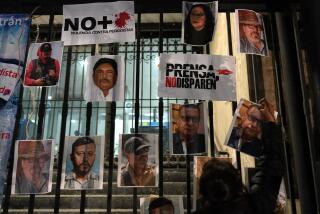Deep Dish Uses $35,000 NEA Grant for Censorship Project : * Television: The seven-part series, airing June 25, deals graphically with sexual matters. The producing network says it has been falsely linked to Cuban interests.
- Share via
An alternative satellite television network has begun to distribute the first of seven hourlong documentaries on what producers say is a nationwide trend toward censorship of a wide spectrum of ideas--from abortion rights to the arts.
Ironically, producers of the project at the New York-based Deep Dish TV Network have defrayed more than a third of the $91,000 cost of the project, “Behind Censorship: The Assault on Civil Liberties,” with a National Endowment for the Arts grant.
The documentaries rely on conventional video techniques--with a strong actuality flavor. However, the series includes some frontal nudity, deals graphically with the alleged censorship of information about safe-sex techniques and depicts public displays of same-sex affection. Those elements are similar to those that, in other NEA-supported projects, have brought criticism of the appropriateness of endowment funding.
But NEA documents--with the authenticity of one having been questioned by the arts endowment--appear to raise deeper questions about the agency’s dealings with Deep Dish. These papers and other sources show that, in internal NEA communications, Deep Dish may have been accused--without its knowledge and in the absence of supporting evidence--of being a tool of the Cuban government. In one memo the network is characterized as “Fidel Castro’s propaganda arm in the U.S.”
Steve Pierce, Deep Dish’s director, categorically denied that the network has any link to Castro. He contended that conservative groups or individuals may have elected to focus on Deep Dish because the network last year aired a documentary strongly criticizing U.S. government sponsorship of the privately operated TV Marti, which beams anti-Castro programming to Cuba.
In addition to the TV Marti documentary, Pierce said, Deep Dish distributed a one-hour compilation of entertainment shows from Cuban television last year. Pierce said he accepted an airline ticket from Castro’s Tourism Ministry to attend a film festival in Cuba last year but paid for his own hotel room and meals. Deep Dish’s programming on Cuba was produced with the assistance of the New York-based Center for Cuban Studies, a free-standing group that arranges travel to Cuba and otherwise tries to promote interaction between the two nations.
Deep Dish, which maintains a progressive, decidedly anti-Establishment political focus, also aired, in March, 1990, a one-hour special from Nicaragua that included a live address by then-Sandinista President Daniel Ortega.
The NEA attempted to disassociate itself from the memorandum making the charge that Deep Dish is a Castro propaganda organ. A spokeswoman said the NEA “had never seen this piece of paper” until NEA Chairman John E. Frohnmayer was asked about it by the congressionally established Investigating Commission last July. However, the document appeared to have been prepared by someone with intimate knowledge of NEA grant-making procedures and access to details of confidential grant application files.
Deep Dish, which distributes its programs to cable systems for use primarily on a patchwork of public access channels and at screenings, received $35,000 in NEA funds this year. The entire sum was applied to the censorship project, which deals extensively with the controversy that has raged over the NEA since 1989, the network said. Deep Dish has a total budget this year of $201,000.
Last week, Deep Dish was notified by the endowment that its application for funds for the 1992 fiscal year had been rejected. Deep Dish had sought $49,880. In the 1989-90 fiscal year, the NEA gave the network $25,000. The NEA does not comment officially on grants it rejects.
One program in the new series--”State of the Art: Art of the State?”--deals with, among other things, ways the arts endowment has sought to assure its survival by, producers contend, engaging in a form of censorship of its own.
“We wanted to step back for a moment from the NEA controversy because we had seen that a lot of people thought it (any broad emergence of censorship initiatives) was just a problem for the artist--the avant-garde on the East and West coasts--and that it wasn’t their problem,” Pierce said. “We wanted a series that showed that this (censorship debate) is part of an overall political struggle in our culture.”
The issue extends, he said, “to homophobia, to reproductive rights, to (the relationship between) church and state and to corporate control of culture--even so far as political prisoners.
“I know that, in this country, debate and dissemination of ideas is severely restricted by corporate control of the media. We are interested in freedom of expression. We’re interested in diversity, social justice issues. We’re interested in getting out ideas and information not available through other means.”
Pierce said the experience with the Castro propaganda charge has brought into sharper focus issues that the new censorship project seeks to address. Lorna Johnson, the series coordinator, said: “We wanted to show that censorship affected people whether they were artists or whether they were people in communities of color or in the gay and lesbian community.
“It has an overriding effect. It is not just an issue for the artist. That is why we have all of these programs, saying, ‘This is your life. Take a look at who’s running things.’ ”
Initially, said Johnson, producers intended to focus on a more conventional concept of censorship--of the book-burning, art-wrecking variety. But, she said, “we looked at (the NEA dispute) and realized this isn’t the beginning of censorship--it has been around for a long time and it has a whole lot of guises.”
The videos, which seek to broaden social conceptions of what constitutes censorship, share common elements in seeking to establish that filtering of ideas and artistic concepts--often by artists or by funding sources not even aware they are pulling their creative punches--is one of the most onerous, if subtle, manifestations of censorship.
In addition to “State of the Art: Art of the State?” the series includes “Access Denied,” dealing with censorship of grass-roots media, including public access channels on cable systems; “In Other Words,” focusing on promotion of intolerance and untoward stereotypes precipitated by use of terminology, and “Who Owns This Body?” and “Forbidden Fruit Strikes Back,” twin segments that take on a variety of issues, including provocative treatment of whether suppression of pornography is an onerous act of censorship or a justifiable policy to safeguard women.
The series also includes “Vibrant Voices,” “Mutiny on the Corporate Sponsor Ship” and “Political Prisoners in the U.S.”
The series will be screened on public access channels on three Southern California cable systems, serving Pasadena, Sierra Madre and Arcadia, starting June 25. The broadcasts will conclude July 11. “State of the Art: Art of the State?” is scheduled for a screening at Barnsdall Art Park in mid-September.
Joy Silverman, a Los Angeles arts administrator who helped produce “State of the Art: Art of the State?” said that episode and the project at large represent an attempt to show how censorship initiatives are the product of forces “that want (public dialogue) to be only one voice, one gender, one race, one religion and only one idea of what family should be and sexuality should be.”
While the structure of the censorship series appeared likely to incite controversy of its own, Deep Dish officials said they were concerned about possible censorship-related ramifications of the Castro connection allegation. Pierce contended that what he characterized as a spurious claim was a manifestation of the censorship atmosphere the new documentary series explores.
More to Read
The complete guide to home viewing
Get Screen Gab for everything about the TV shows and streaming movies everyone’s talking about.
You may occasionally receive promotional content from the Los Angeles Times.






